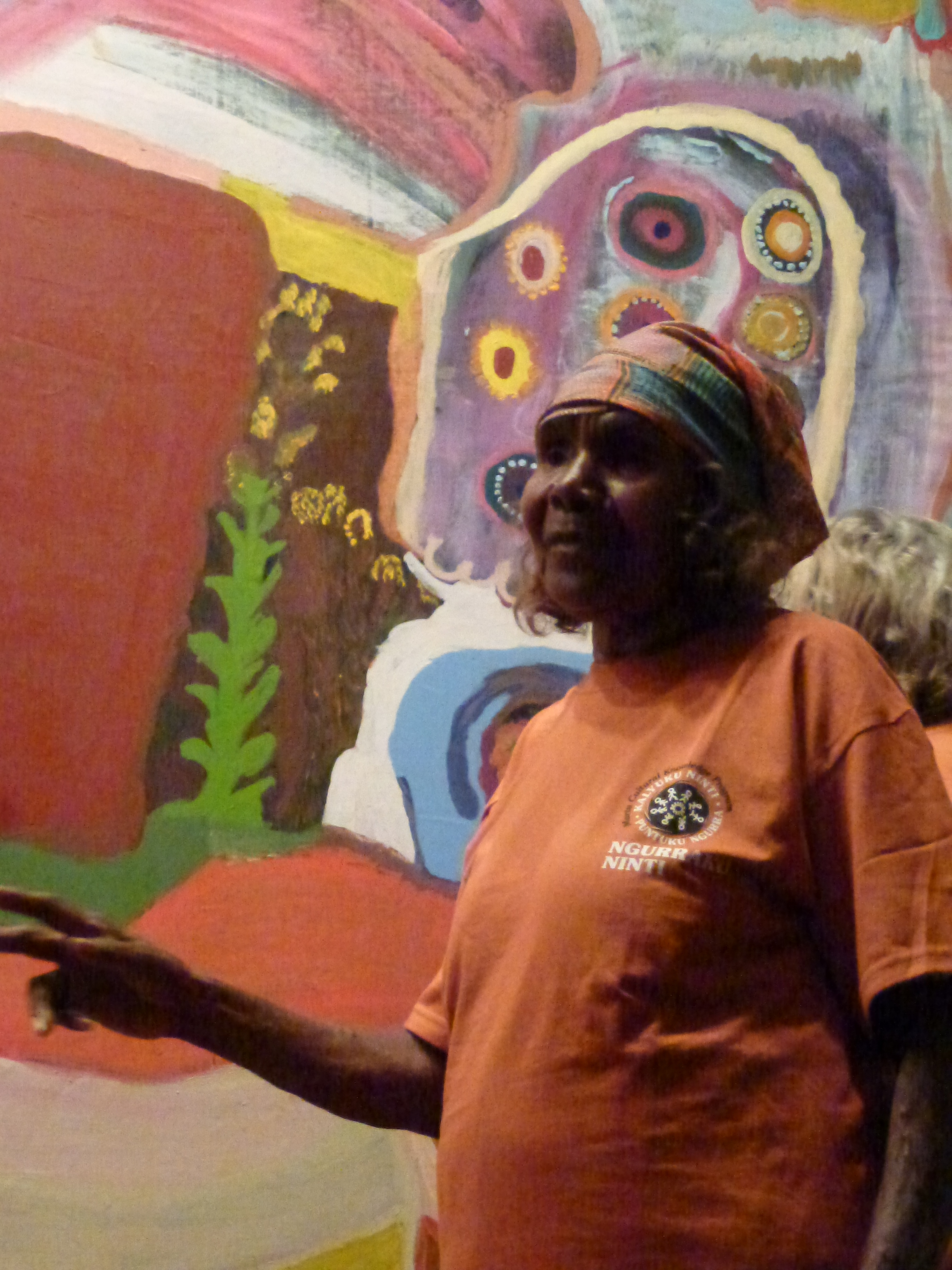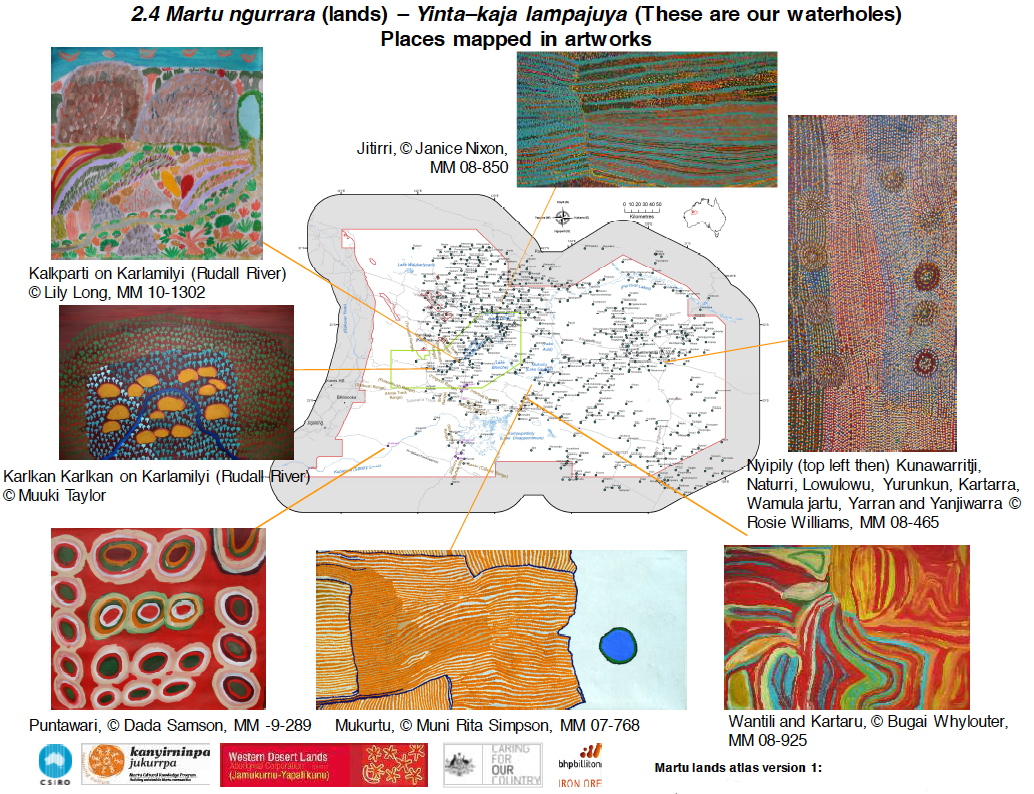Most of us wouldn’t contemplate venturing into the remote central desert region of Australia without a map, not to mention a GPS and a satellite phone in case things got a bit dicey. But for the Martu, who have called the Western Desert home for thousands of years, a map is entirely unnecessary.
A stunning art and multimedia exhibition currently running at the Fremantle Arts Centre, Western Australia, is giving audiences an insight into the depth of local knowledge of the Martu people and the connection they have to their country. It is bringing the desert to the city.
The show, fittingly titled We Don’t Need A Map: A Martu Experience of the Western Desert, features the work of about 40 Martu artists who travelled the 1200 km to present their work in Fremantle. The artists represent many different places across the vast Western Desert and bring their own unique stories to the show.
Warnman woman, Lily Long, explains the large canvas Karlamilyi, which she painted with her sister Amy French. It’s a vibrant landscape depicting places where family were born and died, bush foods, Dreaming places and deep socio-political history.
Fiona Walsh, an ethnoecologist working out of CSIRO Alice Springs, has a long association with the Martu. Fiona and her team provided maps, audiovisual material and information to support the exhibition. This included details they had been documenting about the cultural uses of fire by Martu, plant resource use and spatial geography of Martu lands.
A report compiled by Fiona and her team—which features an atlas of geographical and cultural sites on Martu country and reveals how those are represented in Martu artworks—was part of the inspiration for the exhibition.
An excerpt from our report that helped inspire the exhibition.
The supplementary information provided by CSIRO was used in a hard copy book and catalogue that accompany the exhibition, and provide a rich and accurate context for the artworks.
Speaking on ABC Radio, Gabrielle Sullivan, one of the show’s curators, spoke of how this approach aimed to make the art more accessible for viewers.
All 600 copies of the exhibition book sold within a week of the exhibition opening… but don’t worry it is being re-printed.
ABC Perth was at the opening and captured the atmosphere in this great photo slideshow.
We Don’t Need A Map is showing at the Fremantle Arts Centre until 20 January 2013. If you’re in the Perth area then why not get along.




7th January 2013 at 10:11 pm
Congratulations to both the Martu people and Australia in at least partially righting a great wrong. If they still speak their language then there is a chance for cultural survival.
I am impressed by the artwork both because of its originality and great variety but also because it breaks the main chasm in Western art ie. between figurative and abstract. One would have a hard time defining in these categories Martu painting is it abstract or figurative or neither or both? But it is lyrical beautiful meaningful well composed and of course very colourful.
And their sense of colour is more like Woodland painting here in Northern Ontario.
It is of course much more than decorative and may have something to do with dreamtime.
We have much to learn from them. I have used myself the concept of dreamtime to elucidate our own problems with epistemology theology philosophy aesthetics or metaphysics.
Unless I misunderstand it there are two realities or two world views. One is the world of material objective reality the world of rocks bones soil earth waters sky stars wind animals and plants and the bodies of humans.
It would of course be impoverished nonsense to believe that that is all there is.
On the contrary everything that gives meaning to our lives belongs to dream time everything that is important that is worth living for. Poetry music art literature religion philosophy yes even science and mathematics as well as language itself the concepts of right and wrong beauty and ugliness just and unjust all belong to dream time.
The material means of expressing these things are in the real world but their meaning is only in dreamtime.
The canvas and paint and brush are in the real material world but their meaning is not. It exists only in dream time.
A musical piece whether on a piano or a didgeridoo is on the one hand the musical instrument and the sound waves hitting the eardrum but it’s only noise as received and interpreted by our neural processes but it has meaning only in dreamtime and is thereby perceived as music.
Possession of course has no real meaning or objective reality. It is simply a part of Western mans dreamtime. Started with the cippus of the Etruscans delineating land ownership and city boundaries. In my folly I once said to an Ojibway that the land belongs to them. No he said the land belongs to itself, it belongs neither to the white man nor to the red man for we are both only visitors and if we claim it we are usurpers.
Similarly of course for money. Which first was cowrie shells then precious metal coins in Lydia then paper money in China and then promissory notes in Florence. It has of course neither meaning nor value nor any reality in the real material world but is simply a
construction of Western or Eastern man’s dreamtime.
So the Murra rather Martu never had a conception of ownership of the land but were visitors or traditional inhabitants. Which is why Anglos just took the land from natives here and there for a song and a dance. It meant nothing to them as absurd a concept as
some people indeed are doing already selling deeds to land on the Moon.
Pollution wind earthquakes dust and sandstorms hurricanes typhoons epidemics tsunamis also do not understand the concept of human fantasized boundaries limits or borders.
The material world is not Western or Eastern mans dreamtime.
So instead of a silly and despised or ridiculed anthropological oddity dreamtime becomes a foundational concept of our philosophy which even the Ionian Greeks havent come up with
nor German philosophers but the Australian Aboriginese did.
Dreamtime is no dream but human culture and civilisation for better or worse.
7th January 2013 at 3:54 pm
Chris I’d like a few copies of the book for Limestone. Megan could use one or two.
Oona